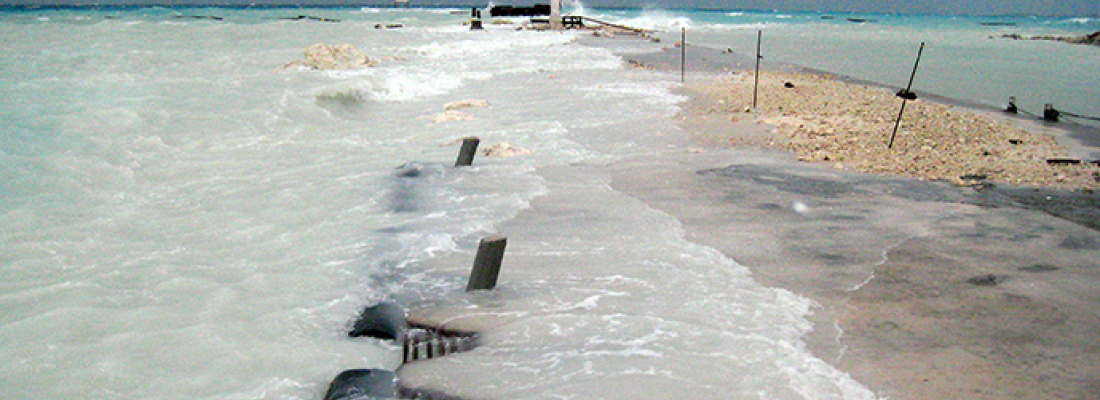Climate change and risks Reading time 3 min
Dealing with rising sea levels
Published on 24 October 2019

The ocean is rising relentlessly and at an increasing rate: +3.5 cm per year over the last decade as compared to +2.7 cm during the preceding one, with climate change driving this quickened pace. According to the latest possible scenarios outlined by the IPCC1, by 2100 the accumulated total could be from + 60 to + 110 cm, due to melting polar ice and mountain glaciers and expanding seawater. The risk is particularly high for the deltas, coastal areas and shorelines that ever increasing numbers of human activity have wrested from the sea for farming, urbanisation, tourism, business, industry and infrastructures. Such coastal areas consist of both ecosystems and fragile lands where communities and economic activities have clustered, often without any overall vision or control over the numerous decisions regarding them. While the current impact of the rise in sea levels is still limited, forecasts portend significant effects on coastlines, habitat, infrastructures, agricultural and tourist activities, ecosystems, and freshwater resources. The increase in extreme weather events also raises concerns about more frequent coastal inundation and flooding into dry inland areas. Over the long-term, the increase in sea levels will force us to rethink both planning in the areas at risk and the safety of the communities involved. In certain situations, consideration will have to be given to moving communities and activities inland away from such hazards, thereby impacting wider areas than just those directly affected by sea level rises.
Already high risks, whatever the scenario considered
The pace of climate change has to slow down if we want to be able to act on the speed and intensity of the rise in sea levels, which supposes strong and coordinated action worldwide. Territorial adaptation depends primarily on local policies. The foresight study’s eight scenarios, divided into three families, made it possible to project the future based on the speed of the sea level rise and the frequency of extreme weather events. They combined those factors, categorised in four levels: moderate, serious, grave or extreme, with different response thresholds such as worldwide governance that may or may not be able to take prompt measures to slow down global warming, and local policies ranging from proactive - via appropriate coastal zone development and/or managing the move inland away from such zones - to “business as usual”.
Overall, the four scenarios in the “Coastal Adaptation” family are the most virtuous, with a bonus for those two that combine local anticipation with governance that makes it possible to mitigate climate change and, therefore, sea level rises, i.e. “Climate Control” or “Sober and Proactive”. In the three Denial family scenarios, no actions are taken commensurate with the gravity of climate and environmental changes until at least 2050. Public policies then finally change due to a surge in water-rise-related disasters. The longer it takes to get a collective reaction, the greater the risk that social relations will become more fractured under the influence of economic, environmental, and humanitarian crises. The “Fragmented World” family scenario simulates a situation where local, regional and national policies differ and are sometimes contradictory. That leads to uneven dynamics based on the “every man for himself” principle.
Assertive and coordinated public policies at the global level before 2040
Governance is a major driver
These experts concluded that governance is a major driver since without assertive public policies at the global level before 2040, acute or extreme situations could occur. Local adaptation efforts mainly aim at dykes, replenishing barrier beaches, strengthening ecosystems and, when such solutions are not possible, managing a move inland to safer areas. They urged the use of reversible solutions as well as nature-based ones in order to avoid poor adaptation. They highlighted the need for multi-disciplinary research involving all the specialists to understand, foresee and measure this phenomenon and assess its impacts. Such research will also have to provide solutions for bringing about the coastal and urban transition, reducing or mitigating inundation, limiting unequal exposure to risk and managing crisis situations.
1 IPCC Intergovernmental Panel on Climate Change
The foresight study’s work was based on nine daylong workshops and the scenario method. In order to consolidate the scenarios and verify their relevance in a variety of contexts, there were also three regional focuses, i.e. on Nouvelle-Aquitaine, a vulnerable French region in which a wide range of work has already been done; on the Netherlands, a particularly sensitive European case; and on Vietnam, a potentially critical case. The foresight study mobilised the efforts of a multidisciplinary group of about 20 experts from 15 agencies, including two IRSTEA specialists. The project team had six members, including three from the soon-to-be inaugurated INRAE, i.e. Audrey Béthinger, Project Head, INRA Delegation for Collective Scientific Expertise, Foresight and Advanced Studies (DEPE); along with Nicolas de Menthière, IRSTEA Director of Public Policy Support, co-facilitator of the AllEnvi cross-sectoral foresight group; and Olivier Mora, Foresight Expert, INRA DEPE, co-facilitator of the AllEnvi cross-sectoral foresight group.
Visit the AllEnvi website
